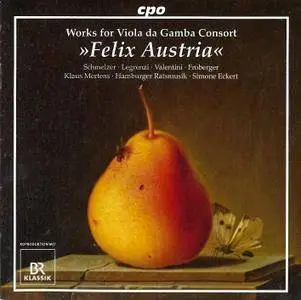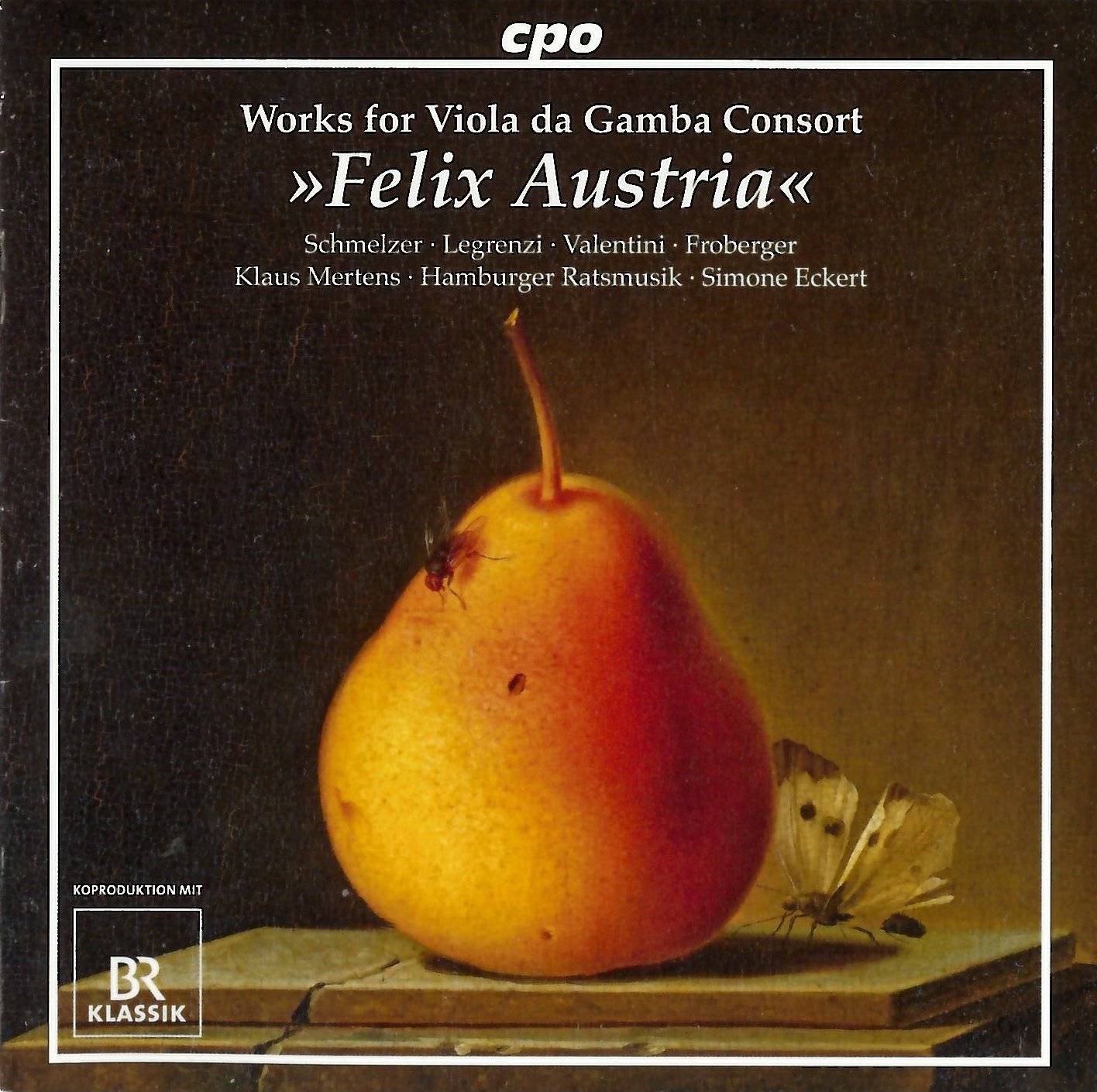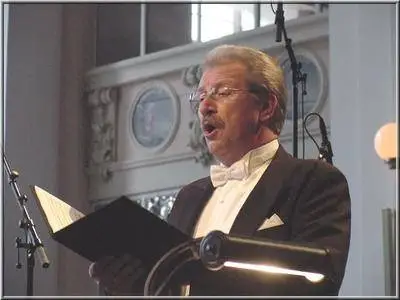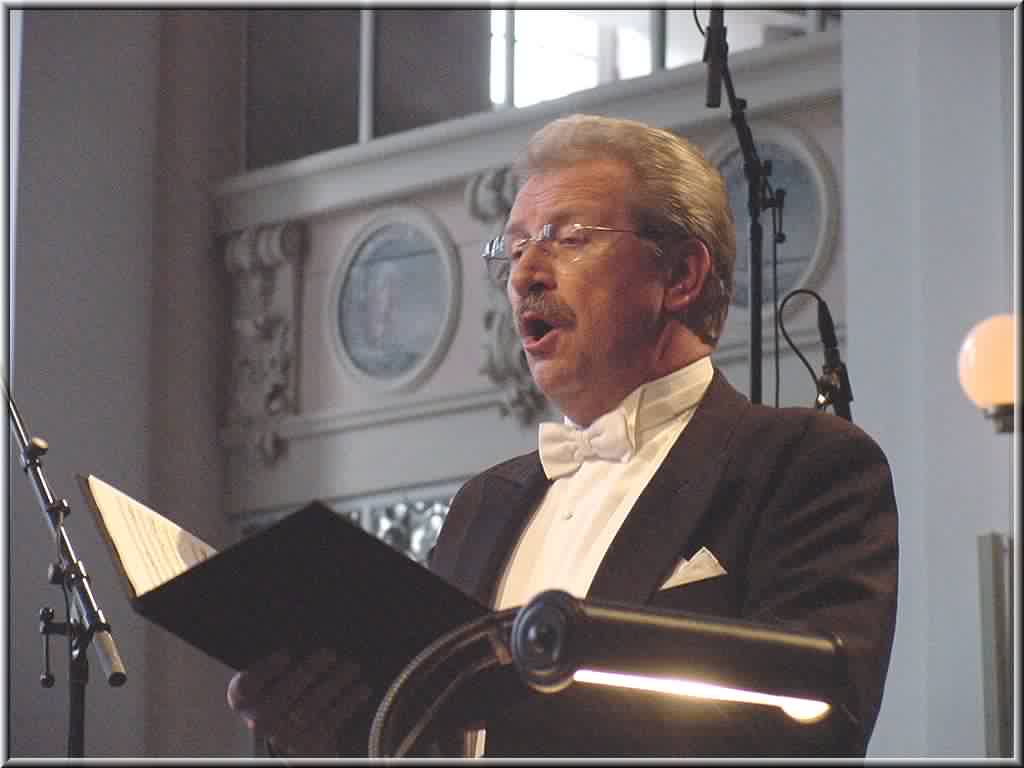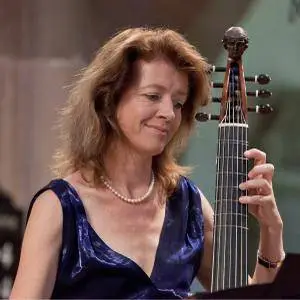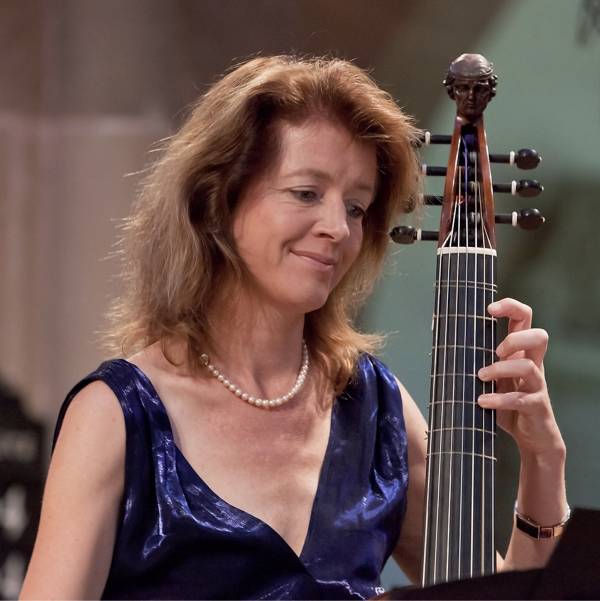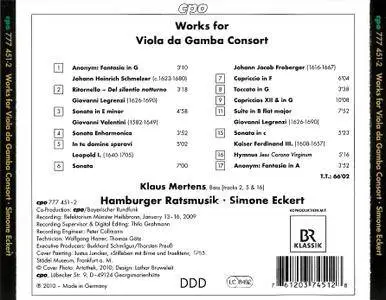Hamburger Ratsmusik, Simone Eckert - "Felix Austria": Works for Viola da Gamba Consort (2010)
EAC | FLAC | Image (Cue&Log) ~ 299 Mb | Mp3 (CBR320) ~ 163 Mb | Scans included
Genre: Classical | Label: cpo | # cpo777451-2 | Time: 01:06:00
EAC | FLAC | Image (Cue&Log) ~ 299 Mb | Mp3 (CBR320) ~ 163 Mb | Scans included
Genre: Classical | Label: cpo | # cpo777451-2 | Time: 01:06:00
Over the years I have heard many recordings of music written for the Imperial court in Vienna. That’s no wonder: Vienna was a centre of music-making in Europe. During the 17th and 18th centuries some of the best musicians and composers were in the service of the Habsburg emperors. Most of the recordings concentrate on music for violins or voice. This disc is different in that it presents music for viol consort. That’s all the more interesting, as it is often thought that in the 17th century consort music was only written in France and England. It is quite surprising that this kind of music was also written in Austria. Most musicians in the service of the Imperial court were from Italy, where the viol consort had gone out of fashion since the first quarter of the 17th century. The fact that Italian composers wrote music for viol consort was due to the personal preferences of the emperors, Ferdinand III and Leopold I, who also wrote some music for this kind of ensemble themselves.
The chosen repertoire is quite remarkable. That is certainly the case with the two pieces by Giovanni Valentini. He was born in Venice, and was appointed organist at the court of Archduke Ferdinand II in Graz in 1614. When Ferdinand was elected Holy Roman Emperor in 1619 he followed him to Vienna, and in 1626 was appointed Kapellmeister. He also served the emperor's successor, Ferdinand III, whom he taught in composition. His motet In te domine speravi is written for bass, viola bastarda and bc. The viola bastarda is not an instrument, but rather a way to play the viola da gamba. In New Grove it is described as a style "which condensed a polyphonic composition (madrigal, chanson or motet) to a single line, whilst retaining the original range, and with the addition of elaborate diminutions, embellishments and new counterpoint". In this particular piece the whole range of the viola da gamba is explored. The result is a strange piece which is a kind of competition between voice and viol, with large leaps in both parts. In effect it is more a musical game than an expressive setting of a text. Klaus Mertens and Simone Eckert master their parts brilliantly.
Even more remarkable is the Sonata Enharmonica. It is based on the fact that in mean-tone tuning A sharp and B flat are not identical. In his liner-notes Michael Fuerst writes: "[The] a-sharp is considerably lower in pitch so as to produce a pure major third with the f-sharp, whereas the b-flat is higher, so as to create a pure major third when played with a d. Valentini repeats the same 2 bars of g-minor music a major third higher, in b-minor, thus juxtaposing a-sharps and b-flats within 4 bars." He adds that viols and lute can play in both pitches by splitting frets. There is no comparable solution for the organ. As here an organ is used in the basso continuo I would have liked to know how this problem was solved. Unfortunately he leaves us guessing. Anyway, it is a most peculiar piece which reflects the sense of experiment of composers in the first half of the 17th century.
Johann Jacob Froberger's music for keyboard isn't without harmonic experiments either. In particular his Capriccio XII which Michael Fuerst plays at the organ, is remarkable for its harmonic progressions. Two of Froberger's pieces are played with viol consort. These are no new discoveries: Froberger had never written music for viol consort, as far as we know. Both are arrangements of keyboard pieces. The Capriccio in G is from a manuscript preserved in the Viennese Gesellschaft der Musikfreunde. The Capriccio in F is inspired by a transcription of a Thuringian court musician, Jacob Ludwig. Apparently he found the task too difficult and stopped after a few bars. This transcription is an attempt by Michael Fuerst, and it really sounds very natural, as if it had been written for viol consort. The Suite in B flat is an arrangement of movements from two harpsichord suites by Froberger, the last of which is one of Froberger's most famous pieces. It sounds very natural on the lute, which is no surprise as lute and harpsichord are idiomatically very close.
The two sonatas by Legrenzi are also notable: the composer had never been in the service of the Imperial court, but he dedicated his op. 10 to Leopold I. The fact that the set contains two sonatas for four viols can only be explained by Leopold's preference for the viol consort. It is a bit odd that these two sonatas are played without the basso continuo which is indicated in the score. This way they seem even more old-fashioned than they are. This decision isn't explained in the liner-notes.
As already mentioned, Ferdinand III and Leopold I were also composers. The first half of the latter's Sonata is largely homophonic, and begins with sequences of ascending and descending scales, with the viols mostly playing in parallel. In the second half there are some solo episodes for the various viols, and the piece ends with a kind of dialogue between one viol and the other three. Throughout echo effects frequently appear. It is not the most interesting piece of consort music I have ever heard but for curiosity's sake it is good that it is included in the programme.
In comparison Ferdinand III seems the greater talent, but maybe the quality of his hymn Jesu Corona Virginum is also due to the composition lessons of Giovanni Valentini. It is a nice piece with five stanzas, which are separated by ritornellos of the viol consort. These are, in turn, reminiscent of the Sonata Enharmonica by Valentini, though without the harmonic experiments.
Without any doubt this is an interesting disc with some highly intriguing repertoire. Most of the pieces have never been recorded before, or - in the case of Froberger - not in this scoring for viols. Klaus Mertens sings the three vocal items with great flair, as one would expect. The Hamburger Ratsmusik is an excellent ensemble, producing a warm sound and playing with great expression. In short, this disc is a worthwhile addition to the discography.Review by Johan van Veen, MusicWeb-International.com
Klaus Mertens, bass
Simone Eckert, viola da gamba & conductor
Klaus Mertens bass ([2], [5], [16])
Hamburger Ratsmusik
Simone Eckert
Tracklist:
01. Anonym: Fantasia in G major (03:10)
Johann Heinrich Schmelzer (c 1623-1680)
02. Ritornello - Del silentio notturno (03:18)
Giovanni Legrenzi (1626-1690)
03. Sonata in E minor (04:58)
Giovanni Valentini (1582-1649)
04. Sonata Enharmonica (03:52)
05. In te domine speravi (05:02)
Leopold I (1640-1705)
06. Sonata (07:00)
Johann Jacob Froberger (1616-1667)
07. Cappricio in F major (06:04)
08. Toccata in G major (03:38)
09. Cappricio XII (04:04)
10. Cappricio in G major (02:22)
11. Suite in B major - Allemande (02:27)
12. Suite in B major - Courante (01:09)
13. Suite in B major - Sarabande (02:09)
14. Suite in B major - Gigue (02:07)
Giovanni Legrenzi (1626-1690)
15. Sonata in C minor (05:23)
Kaiser Ferdinand III (1608-1657)
16. Hymnus 'Jesu Corona Virginum' (05:16)
17. Anonym: Fantasia in A (03:52)
Exact Audio Copy V1.1 from 23. June 2015
EAC extraction logfile from 31. July 2015, 8:29
Hamburger Ratsmusik, Simone Eckert / Works for Viola da Gamba Consort
Used drive : HL-DT-STDVDRAM GU70N Adapter: 1 ID: 0
Read mode : Secure
Utilize accurate stream : Yes
Defeat audio cache : Yes
Make use of C2 pointers : No
Read offset correction : 48
Overread into Lead-In and Lead-Out : No
Fill up missing offset samples with silence : Yes
Delete leading and trailing silent blocks : No
Null samples used in CRC calculations : Yes
Used interface : Native Win32 interface for Win NT & 2000
Used output format : User Defined Encoder
Selected bitrate : 128 kBit/s
Quality : High
Add ID3 tag : No
Command line compressor : C:\Program Files (x86)\Exact Audio Copy\Flac\flac.exe
Additional command line options : -V -8 -T "Date=%year%" -T "Genre=%genre%" %source%
TOC of the extracted CD
Track | Start | Length | Start sector | End sector
––––––––––––––––––––––––––––-
1 | 0:00.00 | 3:10.14 | 0 | 14263
2 | 3:10.14 | 3:18.48 | 14264 | 29161
3 | 6:28.62 | 4:58.65 | 29162 | 51576
4 | 11:27.52 | 3:52.18 | 51577 | 68994
5 | 15:19.70 | 5:02.65 | 68995 | 91709
6 | 20:22.60 | 7:00.21 | 91710 | 123230
7 | 27:23.06 | 6:04.53 | 123231 | 150583
8 | 33:27.59 | 3:38.38 | 150584 | 166971
9 | 37:06.22 | 4:04.46 | 166972 | 185317
10 | 41:10.68 | 2:22.71 | 185318 | 196038
11 | 43:33.64 | 2:27.45 | 196039 | 207108
12 | 46:01.34 | 1:09.06 | 207109 | 212289
13 | 47:10.40 | 2:09.36 | 212290 | 222000
14 | 49:20.01 | 2:07.61 | 222001 | 231586
15 | 51:27.62 | 5:23.68 | 231587 | 255879
16 | 56:51.55 | 5:16.44 | 255880 | 279623
17 | 62:08.24 | 3:52.50 | 279624 | 297073
Range status and errors
Selected range
Filename C:\temp\cpo777451-2_Works for Viola da Gamba Consort (Hamburger Ratsmusik, Eckert)\Works for Viola da Gamba Consort.wav
Peak level 97.2 %
Extraction speed 2.2 X
Range quality 99.9 %
Test CRC 29B42AE2
Copy CRC 29B42AE2
Copy OK
No errors occurred
AccurateRip summary
Track 1 accurately ripped (confidence 4) [DEEC4496] (AR v2)
Track 2 accurately ripped (confidence 4) [42B8B8D7] (AR v2)
Track 3 accurately ripped (confidence 4) [2EF6F07E] (AR v2)
Track 4 accurately ripped (confidence 4) [EFF40D40] (AR v2)
Track 5 accurately ripped (confidence 4) [DC04CBE1] (AR v2)
Track 6 accurately ripped (confidence 4) [AF06A8AA] (AR v2)
Track 7 accurately ripped (confidence 4) [C2282B80] (AR v2)
Track 8 accurately ripped (confidence 4) [A1606511] (AR v2)
Track 9 accurately ripped (confidence 4) [C456F63A] (AR v2)
Track 10 accurately ripped (confidence 4) [551A2703] (AR v2)
Track 11 accurately ripped (confidence 4) [05906DD0] (AR v2)
Track 12 accurately ripped (confidence 4) [72F2F134] (AR v2)
Track 13 accurately ripped (confidence 4) [87938109] (AR v2)
Track 14 accurately ripped (confidence 4) [96189906] (AR v2)
Track 15 accurately ripped (confidence 4) [60D14B3A] (AR v2)
Track 16 accurately ripped (confidence 4) [AA1AD6AD] (AR v2)
Track 17 accurately ripped (confidence 4) [25A2BE2B] (AR v2)
All tracks accurately ripped
End of status report
==== Log checksum D1FA78353D0F11D57B275B6C4196B81D560E96FFA3C4C1925C8B219D2CF0314A ====
EAC extraction logfile from 31. July 2015, 8:29
Hamburger Ratsmusik, Simone Eckert / Works for Viola da Gamba Consort
Used drive : HL-DT-STDVDRAM GU70N Adapter: 1 ID: 0
Read mode : Secure
Utilize accurate stream : Yes
Defeat audio cache : Yes
Make use of C2 pointers : No
Read offset correction : 48
Overread into Lead-In and Lead-Out : No
Fill up missing offset samples with silence : Yes
Delete leading and trailing silent blocks : No
Null samples used in CRC calculations : Yes
Used interface : Native Win32 interface for Win NT & 2000
Used output format : User Defined Encoder
Selected bitrate : 128 kBit/s
Quality : High
Add ID3 tag : No
Command line compressor : C:\Program Files (x86)\Exact Audio Copy\Flac\flac.exe
Additional command line options : -V -8 -T "Date=%year%" -T "Genre=%genre%" %source%
TOC of the extracted CD
Track | Start | Length | Start sector | End sector
––––––––––––––––––––––––––––-
1 | 0:00.00 | 3:10.14 | 0 | 14263
2 | 3:10.14 | 3:18.48 | 14264 | 29161
3 | 6:28.62 | 4:58.65 | 29162 | 51576
4 | 11:27.52 | 3:52.18 | 51577 | 68994
5 | 15:19.70 | 5:02.65 | 68995 | 91709
6 | 20:22.60 | 7:00.21 | 91710 | 123230
7 | 27:23.06 | 6:04.53 | 123231 | 150583
8 | 33:27.59 | 3:38.38 | 150584 | 166971
9 | 37:06.22 | 4:04.46 | 166972 | 185317
10 | 41:10.68 | 2:22.71 | 185318 | 196038
11 | 43:33.64 | 2:27.45 | 196039 | 207108
12 | 46:01.34 | 1:09.06 | 207109 | 212289
13 | 47:10.40 | 2:09.36 | 212290 | 222000
14 | 49:20.01 | 2:07.61 | 222001 | 231586
15 | 51:27.62 | 5:23.68 | 231587 | 255879
16 | 56:51.55 | 5:16.44 | 255880 | 279623
17 | 62:08.24 | 3:52.50 | 279624 | 297073
Range status and errors
Selected range
Filename C:\temp\cpo777451-2_Works for Viola da Gamba Consort (Hamburger Ratsmusik, Eckert)\Works for Viola da Gamba Consort.wav
Peak level 97.2 %
Extraction speed 2.2 X
Range quality 99.9 %
Test CRC 29B42AE2
Copy CRC 29B42AE2
Copy OK
No errors occurred
AccurateRip summary
Track 1 accurately ripped (confidence 4) [DEEC4496] (AR v2)
Track 2 accurately ripped (confidence 4) [42B8B8D7] (AR v2)
Track 3 accurately ripped (confidence 4) [2EF6F07E] (AR v2)
Track 4 accurately ripped (confidence 4) [EFF40D40] (AR v2)
Track 5 accurately ripped (confidence 4) [DC04CBE1] (AR v2)
Track 6 accurately ripped (confidence 4) [AF06A8AA] (AR v2)
Track 7 accurately ripped (confidence 4) [C2282B80] (AR v2)
Track 8 accurately ripped (confidence 4) [A1606511] (AR v2)
Track 9 accurately ripped (confidence 4) [C456F63A] (AR v2)
Track 10 accurately ripped (confidence 4) [551A2703] (AR v2)
Track 11 accurately ripped (confidence 4) [05906DD0] (AR v2)
Track 12 accurately ripped (confidence 4) [72F2F134] (AR v2)
Track 13 accurately ripped (confidence 4) [87938109] (AR v2)
Track 14 accurately ripped (confidence 4) [96189906] (AR v2)
Track 15 accurately ripped (confidence 4) [60D14B3A] (AR v2)
Track 16 accurately ripped (confidence 4) [AA1AD6AD] (AR v2)
Track 17 accurately ripped (confidence 4) [25A2BE2B] (AR v2)
All tracks accurately ripped
End of status report
==== Log checksum D1FA78353D0F11D57B275B6C4196B81D560E96FFA3C4C1925C8B219D2CF0314A ====
foobar2000 1.2 / Dynamic Range Meter 1.1.1
log date: 2016-05-07 12:52:22
––––––––––––––––––––––––––––––––––––––––
Analyzed: Hamburger Ratsmusik, Simone Eckert / Works for Viola da Gamba Consort
––––––––––––––––––––––––––––––––––––––––
DR Peak RMS Duration Track
––––––––––––––––––––––––––––––––––––––––
DR12 -8.00 dB -23.05 dB 3:10 01-Anonym: Fantasia in G major
DR12 -5.65 dB -22.01 dB 4:59 03-Legrenzi: Sonata in E minor
DR10 -8.31 dB -21.18 dB 3:52 04-Valentini: Sonata Enharmonica
DR11 -2.89 dB -19.77 dB 7:00 06-Leopold I: Sonata
DR13 -7.74 dB -24.52 dB 6:05 07-Froberger: Cappricio in F major
DR8 -6.83 dB -17.38 dB 3:39 08-Froberger: Toccata in G major
DR9 -6.33 dB -17.55 dB 4:05 09-Froberger: Cappricio XII
DR11 -7.78 dB -22.90 dB 2:23 10-Froberger: Cappricio in G major
DR13 -6.69 dB -23.89 dB 2:28 11-Froberger: Suite in B major - Allemande
DR10 -7.78 dB -21.78 dB 1:09 12-Froberger: Suite in B major - Courante
DR15 -7.45 dB -25.96 dB 2:09 13-Froberger: Suite in B major - Sarabande
DR13 -6.13 dB -21.74 dB 2:08 14-Froberger: Suite in B major - Gigue
DR13 -3.87 dB -22.46 dB 5:24 15-Legrenzi: Sonata in C minor
DR10 -6.78 dB -19.98 dB 3:53 17-Anonym: Fantasia in A
––––––––––––––––––––––––––––––––––––––––
Number of tracks: 14
Official DR value: DR11
Samplerate: 44100 Hz
Channels: 2
Bits per sample: 16
Bitrate: 609 kbps
Codec: FLAC
================================================================================
––––––––––––––––––––––––––––––––––––––––
Analyzed: Klaus Mertens, Hamburger Ratsmusik, Simone Eckert / Works for Viola da Gamba Consort
––––––––––––––––––––––––––––––––––––––––
DR Peak RMS Duration Track
––––––––––––––––––––––––––––––––––––––––
DR13 -1.33 dB -18.20 dB 3:19 02-Schmelzer: Ritornello - Del silentio notturno
DR15 -0.25 dB -18.56 dB 5:03 05-Valentini: In te domine speravi
DR13 -0.87 dB -17.88 dB 5:17 16-Kaiser Ferdinand III: Hymnus 'Jesu Corona Virginum'
––––––––––––––––––––––––––––––––––––––––
Number of tracks: 3
Official DR value: DR14
Samplerate: 44100 Hz
Channels: 2
Bits per sample: 16
Bitrate: 609 kbps
Codec: FLAC
================================================================================
log date: 2016-05-07 12:52:22
––––––––––––––––––––––––––––––––––––––––
Analyzed: Hamburger Ratsmusik, Simone Eckert / Works for Viola da Gamba Consort
––––––––––––––––––––––––––––––––––––––––
DR Peak RMS Duration Track
––––––––––––––––––––––––––––––––––––––––
DR12 -8.00 dB -23.05 dB 3:10 01-Anonym: Fantasia in G major
DR12 -5.65 dB -22.01 dB 4:59 03-Legrenzi: Sonata in E minor
DR10 -8.31 dB -21.18 dB 3:52 04-Valentini: Sonata Enharmonica
DR11 -2.89 dB -19.77 dB 7:00 06-Leopold I: Sonata
DR13 -7.74 dB -24.52 dB 6:05 07-Froberger: Cappricio in F major
DR8 -6.83 dB -17.38 dB 3:39 08-Froberger: Toccata in G major
DR9 -6.33 dB -17.55 dB 4:05 09-Froberger: Cappricio XII
DR11 -7.78 dB -22.90 dB 2:23 10-Froberger: Cappricio in G major
DR13 -6.69 dB -23.89 dB 2:28 11-Froberger: Suite in B major - Allemande
DR10 -7.78 dB -21.78 dB 1:09 12-Froberger: Suite in B major - Courante
DR15 -7.45 dB -25.96 dB 2:09 13-Froberger: Suite in B major - Sarabande
DR13 -6.13 dB -21.74 dB 2:08 14-Froberger: Suite in B major - Gigue
DR13 -3.87 dB -22.46 dB 5:24 15-Legrenzi: Sonata in C minor
DR10 -6.78 dB -19.98 dB 3:53 17-Anonym: Fantasia in A
––––––––––––––––––––––––––––––––––––––––
Number of tracks: 14
Official DR value: DR11
Samplerate: 44100 Hz
Channels: 2
Bits per sample: 16
Bitrate: 609 kbps
Codec: FLAC
================================================================================
––––––––––––––––––––––––––––––––––––––––
Analyzed: Klaus Mertens, Hamburger Ratsmusik, Simone Eckert / Works for Viola da Gamba Consort
––––––––––––––––––––––––––––––––––––––––
DR Peak RMS Duration Track
––––––––––––––––––––––––––––––––––––––––
DR13 -1.33 dB -18.20 dB 3:19 02-Schmelzer: Ritornello - Del silentio notturno
DR15 -0.25 dB -18.56 dB 5:03 05-Valentini: In te domine speravi
DR13 -0.87 dB -17.88 dB 5:17 16-Kaiser Ferdinand III: Hymnus 'Jesu Corona Virginum'
––––––––––––––––––––––––––––––––––––––––
Number of tracks: 3
Official DR value: DR14
Samplerate: 44100 Hz
Channels: 2
Bits per sample: 16
Bitrate: 609 kbps
Codec: FLAC
================================================================================


